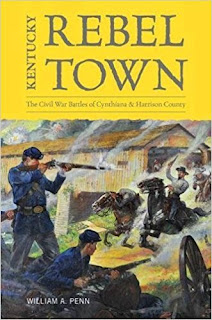By William Penn
Copyright 2016
The University Press of Kentucky
As I review another book, I also review another study of Kentucky in the Civil War. That is certainly a topic that has dominated much of my recent Civil War reading. It has been an enjoyable and informative process - I look forward to finding more on this subject to explore.
Kentucky Rebel Town is a deeply-researched work concentrating on the north-central Kentucky town of Cynthiana and its home of Harrison County. Using information found in many sources such as newspaper accounts, letters, diaries, census records and more, author Bill Penn demonstrates that this county and town offered more moral and military support for the Confederacy than did most of Kentucky, and though support for the Union cause also existed locally, Confederate sympathy was more prevalent, especially before Union troops occupied camps in the area. He makes a persuasive case that Cynthiana truly was a “Rebel Town,” using a wide variety of historical records to support his argument.
This book is well-written, without the distraction of proofreading or editing errors. It compares the Confederate support in Cynthiana to the rest of the state, using information like public events and voting records, as well as biographical information of important local citizens and leaders and the political positions they held. Many different local people and families are mentioned throughout the text, making this a good possible source of information for some genealogists. It also includes an impressive selection of photographs of key people and places discussed throughout the text. Such photographs are always good additions to books like this, and that is the case here.
Among the challenges the author faced when researching and writing this book was a lack of period maps of the area. He did, however, manage to create and include several helpful ones based on his understanding and interpretation of existing evidence and modern development in the area. He also frequently mentions names of modern roads among discussions of old roads where something occurred. This is a helpful part of his writing.
In addition to his interpretation for the maps, the author offers frequent analysis of evidence he found, such as determining the probable location of events, or identities of people when period records were not specific. Such explanations and interpretations of unclear evidence occur often in the book. This goes beyond the mere repeating of established facts and details and adds to the understanding of the events being discussed. This is a strong part of this book and the author’s writing.
This book is a valuable work on many fronts, but especially to people who are interested in Kentucky’s role in the Civil War, its reputation as a Confederate state, and even in-state politics during the war years, especially regarding reaction to Federal policies and occupation. It also provides a detailed look at both the 1862 and 1864 battles of Cynthiana and the fighting done by Confederate General John Hunt Morgan, a key part of this work. Students of Morgan’s career or of Civil War cavalry raids will also find this book to be well worth the time.
The book’s organization is a very good and logical one. It includes end-notes and an informative section showing Union and Confederate Orders of Battle for both battles. Each chapter covers multiple related topics, but each also contains different specific sections for these topics. That helps the book flow more smoothly than books which do not break up chapters thusly, and makes it easier to read and understand. The order of the topics is also sensible, starting with the early war years, then the war and ending with a discussion of how local support of the Confederate cause did not end with the war. The author shows that some people regretted the war’s outcome. This organization makes the book even better.
Overall, Bill Penn’s Kentucky Rebel Town is a fine book, a well-investigated and detailed discussion of how one Kentucky town and county offered more sympathy for the Confederate cause than did most of the state, especially early in the war, It also provides a good overview of the battles of Cynthiana and John Hunt Morgan’s performance in those contests. I find this book to be a terrific addition to the existing studies of Kentucky in the Civil War era and gladly recommend it to fellow Civil War enthusiasts and others interested in Kentucky history.
Location of Cynthiana, courtesy Americancivilwar.com
Note: The author is a member of the Cynthiana Battlefields Foundation group. I am a member of the same group and have met him multiple times. I have tried not to allow this to influence my review, but I thought I should share this information with readers.


Nice review...you might want to post this on Amazon under Bill's book...I am sure he would appreciate it!
ReplyDeleteGood idea!
ReplyDelete